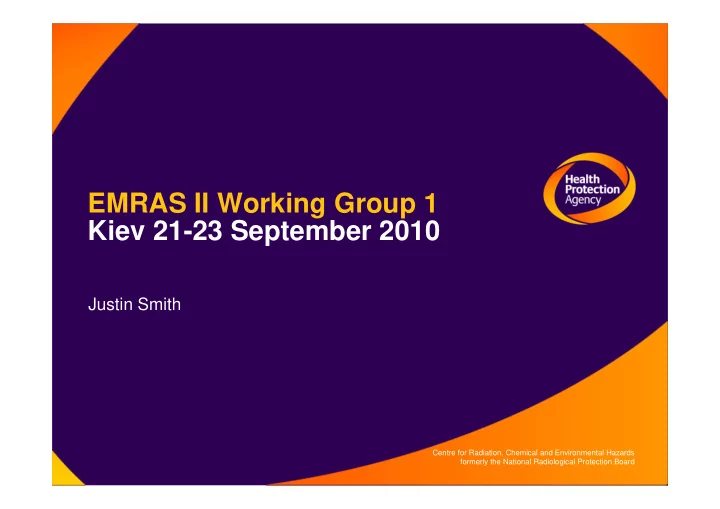

EMRAS II Working Group 1 Kiev 21-23 September 2010 Justin Smith Centre for Radiation, Chemical and Environmental Hazards formerly the National Radiological Protection Board
Scenario A (v2) Releases to the marine environment – results using PC-CREAM 08 Exposure pathway Dose Sv/y Co-60 Cs-137 Sr-90 Internal dose rate from sediments - - - External dose rate from sediments 4.62E-05 5.78E-06 1.55E-07 Internal dose rate from fish 4.00E-07 2.20E-06 1.10E-07 Internal dose rate from crustaceans 1.94E-06 3.22E-07 5.33E-08 Internal dose rate from mollusca 4.42E-07 1.46E-07 1.21E-08 Total dose rate 4.90E-05 8.45E-06 3.30E-07 Health Protection Agency
Scenario A (v2) Comments on marine assessment • Possible inconsistency in use of filtered or unfiltered water concentrations between participants. • I used 1 10 -5 t m -2 y -1 and should be 1 10 -4 t m -2 y -1 (i.e. 1 10 -5 t m -3 y -1 ) but this only has small impact on bed sediment concentrations of a few percent. • Kd (Bq t -1 per Bq m -3 ) – Co = 2 10 5 , Sr = 1 10 3 , Cs = 3 10 3 for coastal regions • Cf (Bq t -1 per Bq m -3 ) – Co = 1 10 3 , Sr = 2, Cs = 1 10 2 for fish – Co = 1 10 4 , Sr = 2, Cs = 3 10 1 for crustaceans – Co = 5 10 3 , Sr = 1, Cs = 3 10 1 for molluscs • PC-CREAM assumes instant dilution of marine discharges into a large volume. Health Protection Agency
Scenario A (v2) Releases to atmosphere – results using PC-CREAM 08 Exposure pathway Dose Sv/y Co-60 Cs-137 I-131 Kr-85 Internal dose rate from inhalation 4.96E-06 2.28E-06 3.65E-06 0 External dose rate from air immersion (cloudshine) 3.56E-08 1.80E-09 5.50E-09 2.82E-10 External dose rate from groundshine 1.35E-04 1.07E-04 3.95E-06 0 Internal dose rate from ingestion of green vegetables 5.56E-07 2.31E-06 1.25E-05 0 Internal dose rate from ingestion of root vegetables 2.78E-08 7.08E-06 7.93E-06 0 Internal dose rate from ingestion of domestic fruits 2.50E-08 9.06E-07 1.28E-06 0 Internal dose rate from ingestion of cow produce (milk) 4.36E-06 8.86E-06 4.10E-05 0 Internal dose rate from ingestion of cow produce (beef) 3.37E-06 6.09E-06 1.81E-06 0 Internal dose rate from ingestion of sheep produce 3.19E-08 7.42E-07 1.29E-07 0 External dose rate from direct radiation 4.00E-06 4.00E-06 4.00E-06 4.00E-06 Total dose rate 1.52E-04 1.39E-04 7.63E-05 4.00E-06 Health Protection Agency
Scenario A (v2) Comments on atmospheric assessment • I used adult inhalation dose coefficient for Co-60 of 1 10 -8 (not 3.1 10 -8 ) Sv Bq -1 • Depth of top mixed soil layer 0.3 m not 0.1 m • Transfer parameter for radionuclide uptake in crops from soil was in terms of wet mass plant to dry mass soil • For translocation used fixed parameter values for semi- mobile or mobile • Differences in dose from ingestion of some terrestrial foods could be further investigated by comparison of deposition rates. • Transfer parameter from air immersion to human dose for Kr-85 ~ 2.82 10 -10 /7.24 10 -2 = 4 10 -9 Sv y -1 per Bq m -3 Health Protection Agency
Scenario B Defining the representative person • Information required – The discharge • Discharge routes • Discharged radionuclides • Exposure pathways – Habit surveys • Age groups • Ingestion rates • Inhalation rates • Location • Occupancies • Dwellings Health Protection Agency
Scenario B Defining the representative person • The previous data would be reviewed to identify potential candidates for critical groups/representative person. A full set of exposure pathways would be considered for – Those most exposed to atmospheric discharge • Consider high consumers of terrestrial foods • Individuals spending a lot of time outdoors close to the site – Those most exposed to marine discharge • Consider high consumers of marine foods • Individuals spending a lot of time outdoors along the coast – Those most exposed to combined discharges • Habits are such that summed exposure from atmospheric and aquatic discharges may be significant Health Protection Agency
Scenario B Defining the representative person • Review of habit data may indicate that a single group represents two or more of the previous categories • Review of habit data may indicate that supplementary data are required eg make assumptions about locations (eg 0.5 km and 5 km), use data from distributions based on national habit surveys, the ‘Top-Two’ approach may be used. • Dose assessments carried out for the selected groups to identify critical group/representative person. Health Protection Agency
Scenario B • So it is likely that dose assessments would be done for very similar groups to those identified by EA (see below) and the worst case group would be selected for the critical group/representative person. 1. Atmospheric pathway exposure groups Green vegetable consumers Root vegetable consumers Domestic fruit consumers Milk consumers Sheep meat consumers Occupants for plume pathways (inner area) 2. Aquatic pathway exposure groups Sea fish consumers Crustacean consumers Mollusc consumers Occupants for exposure - Sediment Health Protection Agency
Recommend
More recommend